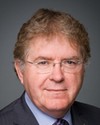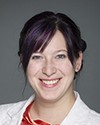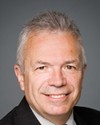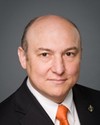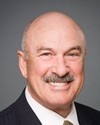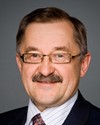Thank you, Mr. Chair.
Members of the committee, good afternoon. Bonjour. It really is a privilege for me to be here today as the new Chief of the Defence Staff. As I sit here, I am struck that even though we are in slightly different uniforms, we are all serving the great people of this great nation.
Before I begin, I would like to express my sincere appreciation for the important work you do, both in Parliament and specifically in this committee. Thank you for the attention and oversight you give, time and again, to pressing Canadian defence issues.
Further, having met some of you already, I understand that some of you have had distinguished service, and I know that all of you have intense interest in the Canadian armed forces. It really is an honour for me to join you here today.
I have been in the Canadian armed forces for over 35 years, and I come from a family with some military tradition. I am the son of a Second World War Spitfire and Mustang pilot and the grandson of a transplanted Scotsman who fought in the trenches in France, and I am now the father of a couple of young servicemen. My family is quite typical of the very rich history and heritage of many families in the Canadian armed forces.
Thanks in great part to my predecessors, the Canadian Armed Forces have developed a solid foundation of skill, experience and expertise that will allow us to meet whatever challenges come our way. So it is with a profound appreciation for those who have served before me, but also with an eye firmly fixed on the future, that I will serve this country as the 18th Chief of the Defence Staff.
Members of the committee, today marks the end of my first month in this term as Chief of the Defence Staff, and in the past few weeks I've gained a deeper understanding of where we are as an organization and of the challenges and opportunities before us. This afternoon, I will share with you my priorities for the Canadian armed forces going forward.
The Canadian Forces are a dynamic institution operating in a dynamic environment, and we see that all the time. Like any vibrant organization, we're constantly learning lessons and adjusting course accordingly, so I would expect my priorities to evolve as time goes on. But as a starting point, I envision four key areas of focus presented to you as a whole, and not necessarily in order of importance, this afternoon. These are: leading the profession of arms; delivering excellence in operations; caring for our people and their families; and, finally, preparing for our forces of tomorrow.
Let me begin with leading the profession of arms.
It is an honour and a privilege to wear this uniform, but it also comes with a profound responsibility. As military members, we must meet the highest standards of professionalism.
We must uphold the four core military values: duty, loyalty, integrity, courage. Ultimately we must be willing to sacrifice everything in the service of the country.
The high calibre of our men and women in uniform is widely recognized across Canada and around the world. Indeed, I believe that because of our track record of service and sacrifice we have developed a strong relationship of respect and trust with Canadians from coast to coast to northern coastline. As CDS, it's my responsibility to ensure that we continue to exercise good, sound judgment in everything we do, and that we continue to uphold the highest ethical standards to maintain the trust of Canadians. It's also my intention that our forces continue to receive the necessary education and training to ensure that this level of professionalism endures.
As you probably know, I spent some time commanding the Royal Military College in Kingston, so the importance of professional development for our officers and NCMs is firmly ingrained in me.
It's the planning, the preparation, and the integration of all skill sets, expertise, and experience across the defence team that enable operations. Quite simply, professional development and a culture of continuous learning are essential to success and operations, which brings me to the priority of delivering excellence in operations.
Members of the committee, I command the Canadian armed forces as they work to protect and serve Canadians and operations here at home, to work alongside our American counterparts in the common defence of North America, and to project Canadian leadership and contribute to international peace and security abroad in places like Afghanistan, Libya, and the Mediterranean Sea.
The last few years have been particularly busy ones for our forces. Although the pace is not as hectic as it was, there's still a lot of operational work that continues.
Today, we still have over 1,600 military personnel serving Canada around the world: in maritime security and counterterrorism operations in the Arabian Sea; in UN missions in places like Cyprus, Haiti, the Democratic Republic of Congo, and the Middle East; and of course with some 950 Canadians with the NATO training mission in Afghanistan, where Canada remains the second largest contributor to that vital mission of training and transition.
That list, of course, is not exhaustive. We have troops deployed on 15 operations around the world. In fact, I will visit some of our deployed troops next week to see first-hand the tremendous work they are doing.
We also have forces stationed from coast to coast to coast, standing ready to help Canadians in case of emergency or disaster, undertaking search and rescue missions at sea and in the air, monitoring and defending our maritime and air approaches, and contributing to Canada's sovereignty in the Arctic.
So while the current operational tempo has changed, I would not say that things are slow.
As every mission we undertake is a no-fail mission, delivering excellence in operations remains paramount on my agenda.
Carrying out our operations in a wide variety of environments and circumstances—both here in Canada and around the world—requires a concerted effort by everyone on the defence team.
I want to underline that the key to our operational success has been, and always will be, our men and women in uniform. They are the ones who deliver—on the ground, in the air, on the sea—whatever the mission. These men and women deserve the best support to position them for the excellence they unfailingly achieve.
This leads me to the next priority, caring for our people. I mean this in the broadest sense. Our military family is large and comprises not only our men and women serving in uniform and the great civilian team in the department, but also their families, our veterans, and of course our wounded warriors. We must provide the necessary care and support to our military members, regular and reserve force, throughout their service career.
We are acutely aware of the toll that military service can take on our men and women physically, mentally, and emotionally, and of course the toll it can take on their families.
Much has been done in recent years to improve the care and support available to our whole military family, like the physical and mental health services for our ill and injured personnel, the career counselling and financial support for education for those transitioning into the civilian workplace, and the compassionate services for the families of the fallen. But when you meet a soldier who is silently suffering from post-traumatic stress disorder, or you try to comfort the family of those who have lost a loved one, you know that we can always do better. Indeed, as Rear-Admiral Smith explained to you just last week, continuous improvement is a key pillar of our approach to caring for our ill and injured, and I'm firmly committed to that.
l'm also studying the ombudsman's latest report on the treatment of injured reservists and would like to highlight that we are not tackling these issues in isolation.
Reservists are an integral part of our military family, and I am committed to ensuring that they are given fair and equitable treatment.
Supporting our military also means effectively preparing them for their work tomorrow. This is the final priority I'll present today. We've learned a lot in recent operations—particularly in Afghanistan—and we must use this knowledge as we plan for the future. But we must also ensure that the soldiers, sailors, airmen, and airwomen who we send into harm's way have the right tools and equipment to keep them safe.
The Canada First defence strategy has served as an excellent blueprint for the government's systematic modernization of the Canadian armed forces to ensure that we are agile and combat ready.
We've been re-equipping the army with land combat vehicles, providing the air force with new tactical and strategic airlift, and modernizing the navy's frigates, while planning for the replacement of the entire surface fleet through the national shipbuilding procurement strategy.
These equipment renewals are key to our military's readiness and, ultimately, to our operational success.
The Canada First Defence Strategy remains our framework going forward.
We will continue to deliver the commitments made in the Canada First defence strategy, even as we do our part to help government to return to a balanced budget. That is why we are increasingly thinking of how a mix of complementary systems and technologies, a sort of system of systems, could get the job done more efficiently. Acquisitions we have made through the Canada First defence strategy have enabled the success of our ready forces and will continue for the days ahead.
The creation of the Chief of the Defence Staff position almost 50 years ago was about improving coordination and establishing true unity of purpose within the Canadian armed forces, but it was also about streamlining decision-making structures to be more cost-effective. So the times we find ourselves in at present are not so unique. The Canadian armed forces are not new to the challenge of building flexible, agile, and resilient forces while adjusting to fiscal constraints. In order to deliver on the four priorities I've just spoken to you about, it's clear we must address today's budgetary challenge.
In fact, it necessitates a determined and focused effort by the defence team to ensure our resources are being put to best use.
That is why the defence department has created a defence renewal team to help us identify and eliminate ineffective practices and ensure that taxpayer dollars are being put to best use. As the Prime Minister expects of us, we are working to free up resources that can be reallocated to our front lines. As you've heard, more tooth, less tail.
Some changes have been made already through the CF transformation with the stand-up of the Canadian Joint Operations Command this fall, with a plan to reduce administrative overhead by 25% and to redirect those resources to the ready force. I will make it my priority to ensure that this critical work will move forward in the months to come.
In conclusion, members of the committee, thank you again for your ongoing interest in what we do. As you know so well, the defence team has been very busy in recent years, and you can now see that our agenda will continue to be filled, but we have a great team.
I am immensely proud to lead such a skilled and professional institution. And I know we are capable of tackling whatever challenges lay ahead.
As CDS, I look forward to working under the leadership of Minister MacKay and alongside Deputy Minister Fonberg and the civilian defence team. Together, through sound governance, the Department of National Defence and the Canadian armed forces will continue to embody the highest ideals of public service in defending the sovereignty and interests of our great nation.
Thank you. Merci beaucoup.


